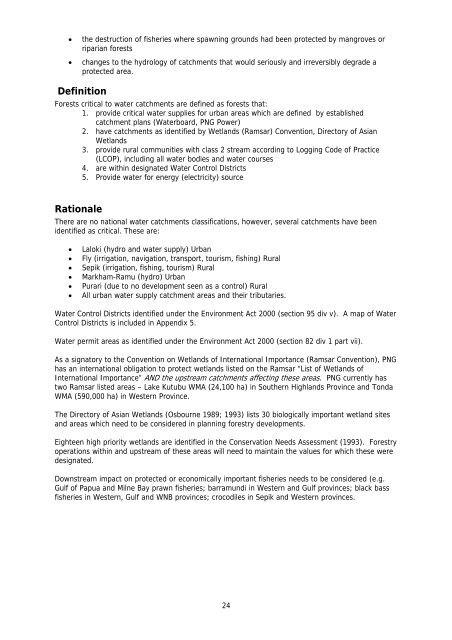A National Interpretation of the High Conservation Value Forest ...
A National Interpretation of the High Conservation Value Forest ...
A National Interpretation of the High Conservation Value Forest ...
You also want an ePaper? Increase the reach of your titles
YUMPU automatically turns print PDFs into web optimized ePapers that Google loves.
• <strong>the</strong> destruction <strong>of</strong> fisheries where spawning grounds had been protected by mangroves or<br />
riparian forests<br />
• changes to <strong>the</strong> hydrology <strong>of</strong> catchments that would seriously and irreversibly degrade a<br />
protected area.<br />
Definition<br />
<strong>Forest</strong>s critical to water catchments are defined as forests that:<br />
1. provide critical water supplies for urban areas which are defined by established<br />
catchment plans (Waterboard, PNG Power)<br />
2. have catchments as identified by Wetlands (Ramsar) Convention, Directory <strong>of</strong> Asian<br />
Wetlands<br />
3. provide rural communities with class 2 stream according to Logging Code <strong>of</strong> Practice<br />
(LCOP), including all water bodies and water courses<br />
4. are within designated Water Control Districts<br />
5. Provide water for energy (electricity) source<br />
Rationale<br />
There are no national water catchments classifications, however, several catchments have been<br />
identified as critical. These are:<br />
• Laloki (hydro and water supply) Urban<br />
• Fly (irrigation, navigation, transport, tourism, fishing) Rural<br />
• Sepik (irrigation, fishing, tourism) Rural<br />
• Markham-Ramu (hydro) Urban<br />
• Purari (due to no development seen as a control) Rural<br />
• All urban water supply catchment areas and <strong>the</strong>ir tributaries.<br />
Water Control Districts identified under <strong>the</strong> Environment Act 2000 (section 95 div v). A map <strong>of</strong> Water<br />
Control Districts is included in Appendix 5.<br />
Water permit areas as identified under <strong>the</strong> Environment Act 2000 (section 82 div 1 part vii).<br />
As a signatory to <strong>the</strong> Convention on Wetlands <strong>of</strong> International Importance (Ramsar Convention), PNG<br />
has an international obligation to protect wetlands listed on <strong>the</strong> Ramsar “List <strong>of</strong> Wetlands <strong>of</strong><br />
International Importance” AND <strong>the</strong> upstream catchments affecting <strong>the</strong>se areas. PNG currently has<br />
two Ramsar listed areas – Lake Kutubu WMA (24,100 ha) in Sou<strong>the</strong>rn <strong>High</strong>lands Province and Tonda<br />
WMA (590,000 ha) in Western Province.<br />
The Directory <strong>of</strong> Asian Wetlands (Osbourne 1989; 1993) lists 30 biologically important wetland sites<br />
and areas which need to be considered in planning forestry developments.<br />
Eighteen high priority wetlands are identified in <strong>the</strong> <strong>Conservation</strong> Needs Assessment (1993). <strong>Forest</strong>ry<br />
operations within and upstream <strong>of</strong> <strong>the</strong>se areas will need to maintain <strong>the</strong> values for which <strong>the</strong>se were<br />
designated.<br />
Downstream impact on protected or economically important fisheries needs to be considered (e.g.<br />
Gulf <strong>of</strong> Papua and Milne Bay prawn fisheries; barramundi in Western and Gulf provinces; black bass<br />
fisheries in Western, Gulf and WNB provinces; crocodiles in Sepik and Western provinces.<br />
24

















